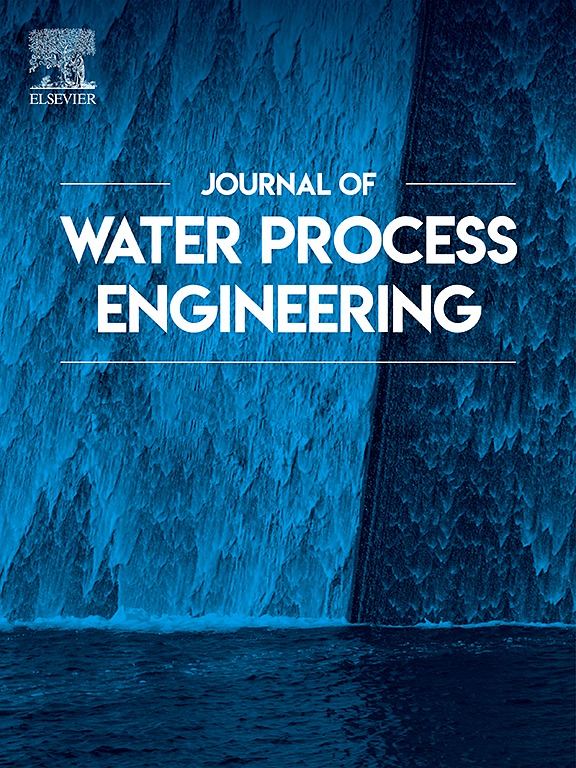Enhanced charge transferring through defects-mediated metal‑carbon nanocomposites for efficient dye degradation under visible light
IF 6.3
2区 工程技术
Q1 ENGINEERING, CHEMICAL
引用次数: 0
Abstract
The photocatalytic efficiency of TbFeO3 photocatalyst was enhanced by generating defects, e.g., oxygen-vacancies (OVs) via Zr-doping (1–5 mol%) at the Fe site and constructing its nanocomposite. With the physiochemical, and optical characterizations catalytic efficiency of samples was tested by photo-degradation of methylene blue (MB) under visible-light irradiation. The study demonstrated that 5 mol% (ZTF-5) exhibited the highest photocatalytic potential due to the formation of OVs on the surface in maintaining charge neutrality. Later, metal‑carbon CN/ZTF-5 nanocomposite was developed by coalescing ZTF-5 with g-C3N4 to improve its photocatalytic potential, which displayed 97.75 % photo-degradation in 90 min that is 1.13 and 1.20, 1.34, 1.40 and 1.51-fold higher than ZTF-5, CN, ZTF-3, ZTF-1, and TF respectively. The enhanced photocatalytic performance attributed to the presence of OVs which play a role in mediating e−h+ pairs separation in CN/ZTF-5 by lowering their recombination rate and charge-transfer resistance, verified by XPS, photoluminescence (PL), and electrochemical impedance spectroscopy (EIS) respectively. Additionally, with optimization of reaction parameters (pH, catalyst and H2O2 dose, dye concentration, and reaction time), reaction kinetics (rate constant for CN/ZTF-5 = 0.039 min−1), scavenger experiment (•O2− radicals; primary reacting species), and the recycling potential of 81.23 % was achieved by CN/ZTF-5 after 4th runs. The photo-degradation mechanism of CN/ZTF-5 was explored based on band-edge potential calculated by Mott-Schottky analysis. Eventually, reaction parameters were studied using statistical analysis of response surface methodology with central composite design. This study implies that defects-engineered catalysts can enhance degradation rate and efficiency of industrial wastewater (textile and cosmetics) remarkably.

求助全文
约1分钟内获得全文
求助全文
来源期刊

Journal of water process engineering
Biochemistry, Genetics and Molecular Biology-Biotechnology
CiteScore
10.70
自引率
8.60%
发文量
846
审稿时长
24 days
期刊介绍:
The Journal of Water Process Engineering aims to publish refereed, high-quality research papers with significant novelty and impact in all areas of the engineering of water and wastewater processing . Papers on advanced and novel treatment processes and technologies are particularly welcome. The Journal considers papers in areas such as nanotechnology and biotechnology applications in water, novel oxidation and separation processes, membrane processes (except those for desalination) , catalytic processes for the removal of water contaminants, sustainable processes, water reuse and recycling, water use and wastewater minimization, integrated/hybrid technology, process modeling of water treatment and novel treatment processes. Submissions on the subject of adsorbents, including standard measurements of adsorption kinetics and equilibrium will only be considered if there is a genuine case for novelty and contribution, for example highly novel, sustainable adsorbents and their use: papers on activated carbon-type materials derived from natural matter, or surfactant-modified clays and related minerals, would not fulfil this criterion. The Journal particularly welcomes contributions involving environmentally, economically and socially sustainable technology for water treatment, including those which are energy-efficient, with minimal or no chemical consumption, and capable of water recycling and reuse that minimizes the direct disposal of wastewater to the aquatic environment. Papers that describe novel ideas for solving issues related to water quality and availability are also welcome, as are those that show the transfer of techniques from other disciplines. The Journal will consider papers dealing with processes for various water matrices including drinking water (except desalination), domestic, urban and industrial wastewaters, in addition to their residues. It is expected that the journal will be of particular relevance to chemical and process engineers working in the field. The Journal welcomes Full Text papers, Short Communications, State-of-the-Art Reviews and Letters to Editors and Case Studies
 求助内容:
求助内容: 应助结果提醒方式:
应助结果提醒方式:


